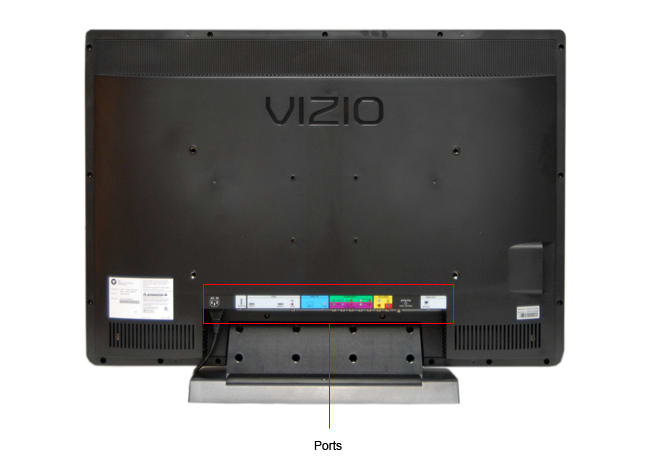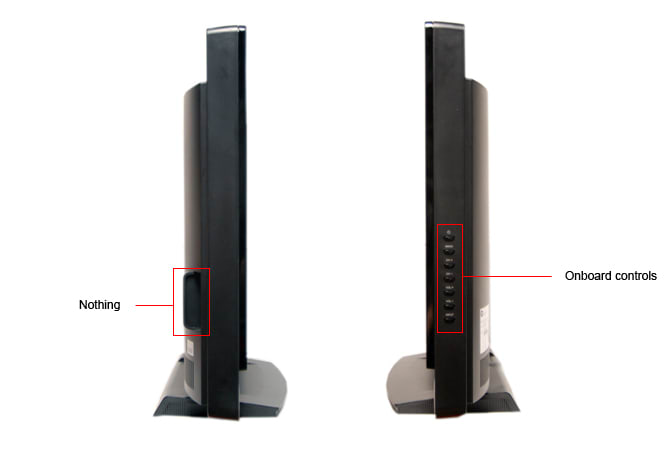Pros
Cons
Introduction
Tour & Design
Front
The Vizio VW32L is a big, boxy TV; it's not all that pretty to look at. From the front, you can see a thick bezel and the speaker grills under the display. More stylish TVs typically hide the speakers underneath (called 'downward-firing' speakers).

Back
The back of the Vizio VW32L is home to all the ports, which are exceptionally hard to access. The labels face out for easy viewing, but the actual ports are hidden underneath a little shelf, and impossible to see unless you're crouching. It's very poor design. For information about the ports on the back of the Vizio VW32L see our Connectivity section.

Sides
The sides of the Vizio VW32L are unusually barren of features, considering how thick they are. On one side, you can see the onboard controls, but on the other side you won't find a single port. Strangely, there's a patch of space where ports or controls *could *be, but Vizio clearly opted out for this particular model. For information about the ports on the Vizio VW32L see our Connectivity section.

Stand/Mount
The base of the Vizio VW32L is pretty flimsy, but it more than suffices for this small TV. Note: this base does not swivel. Sorry.
Controls
The onboard controls on the Vizio VW32L are all quite standard: power, menu, channel up/down, volume, and input. The buttons themselves are hard plastic and respond well when touched.

Remote Control
The remote control is stripped down, compared to most HDTV remotes. There are precious few buttons, and any advanced features are buried somewhere in the menu. For more details, read the Remote Control section of this review.
In The Box*(6.0)*
The Vizio VW32L is an inexpensive TV, so don't expect much. It comes with the stand, a remote control, batteries, and an instruction manual. You won't find any cables, though, or any other easter eggs.
Aesthetics*(4.0)*
The Vizio VW32L would be hard to describe as pretty. It's boxy, with a matte finish. The speaker grills on the front definitely give it a 90s look. But it's cheap and functional, so don't ask for much.
Blacks & Whites
Black Level*(5.10)*
The Vizio VW32L produced a lackluster black level score, which was as bright as 0.38 cd/m2. As you can see from the chart below, the Memorex was nearly as bad. The Insignia and Samsung were far superior. Practically speaking, this means that the Insignia and Samsung are going to produce deeper, more satisfying shadows when you're watching old detective movies or Lost. The Vizio VW32L also can't do as good a job producing deep blacks and bright whites at the same time, evinced in most of the tests on this page. (More on how we test Black Level.)
Peak Brightness*(8.44)*
The Vizio VW32L also produced a rather weak Peak Brightness score, as you can see below. It was, in fact, the dimmest of the competition, at only 310 cd/m2. In truth, having a really bright white is probably less important than having a deep black level. But overall, this simply indicates the limitations of the Vizio. (More on how we test Peak Brightness.)
Contrast*(5.72)*
The contrast ratio of the Vizio VW32L is really quite stunted, only 818:1. Now, we're not surprised that it didn't match up to the 5500:1 Dynamic *contrast ratio Vizio states on its website, but that's a tricky sort of math that they can fudge. We measure the actual contrast ratio: the brightest and the darkest that a TV can produce *at the same time. Dynamic contrast ratio is the theoretical range that a TV can produce if you play with the brightness, contrast, and backlight settings. Either way, it's still not impressive. (More on how we test Contrast.)
Tunnel Contrast*(9.91)*
The tunnel contrast for the Vizio VW32L was almost completely even, and satisfactory. You don't need to worry much about losing your black levels when there's only a little shadow surrounded by a lot of brightly lit content. (More on how we test Tunnel Contrast.)
White Falloff*(9.81)*
The white falloff was also even, so you don't need to worry about losing any of the brightness in your whites (dim as they are) when those whites are surrounded by shadows. (More on how we test White Falloff.)
Uniformity*(8.5)*
The screen uniformity of the Vizio VW32L is rather good. We didn't see any noticeable hotspots, even when the screen was completely black (when problems are most evident). There was the usual flashlighting in the corners, but it was so minor that most people wouldn't notice. (More on how we test Uniformity.)
Greyscale Gamma*(8.2)*
The greyscale gamma results indicate that the Vizio VW32L is not perfect at making a smooth transition from shadows to highlights. The slope of the curve measured 2.5, while an ideal score is somewhere between 2.1 and 2.2. The Vizio's ramp-up is too steep. (More on how we test Greyscale Gamma.)
Now, look at the lower-left end of the line in the chart below. Those are the shadows, and the fact that it's so flat means that the TV is missing a lot of detail there. TV's never have a perfectly straight line, but we're not happy with what we see here in the shadows.
Resolution Scaling*(5.08)*
The Vizio VW32L is a TV with a native 720p display. But the world we live in has a lot of content that comes in other resolutions. Read below for details on each alternate resolution. Overall, the Vizio VW32L proved to be rather uneven its performance. (More on how we test Resolution Scaling.)
480p
The Vizio VW32L handled 480p content very well, upscaling with very little problem. The screen lost 2% all around due to overscanning, but had no problem displaying things like fine text or high frequency patterns.
1080i
When confronted with 1080i content, the Vizio VW32L did not do as well. It lost 3% of the edges due to overscan, which is a lot, especially if you're displaying a computer input. When it tried high frequency patterns, we saw a fair amount of Moire patterns emerging.
1080p
With 1080p content, we saw the same problems as with 1080i: three-percent loss due to overscan and trouble with high frequency patterns.
Color Accuracy
Color Temperature*(8.66)*
The color temperature consistency of the Vizio VW32L is very good. As you can see from the chart below, we ran the TV through the gamut, from darkest to brightest signals, and the TV almost never strayed into the 'perceptible error limit,' meaning you could not see the change. Only at the very brightest signals did the whites warm up a little, which may cause a reddish tinge of color. (More on how we test Color Temperature.)
RGB Curves*(8.18)*
The RGB curves that the Vizio VW32L produced are good. Looking at the chart below, what you want to see is a smooth line with as little aberration or horizontal flat-lining as possible. (More on how we test RGB Curves.)
The lines are indeed pretty smooth. The blue channel shows the most jaggedness. To the eye, this would be characterized by color banding, which we did see during the review process. However, we like that the red, green, and blue channels all move in a more-or-less seamless curve. No one channel in particular failed. On the down side, you'll notice the flatness of the curve on the lower left side. That's where the TV failed to find much information in the shadows and darker colors. We saw the same results in our black and white testing. This TV does not handle blacks very well.
Below are a series of digitally recreated color strips that represent the color curves above. As you can see, none of the TVs quite match the ideal performance, but these strips make it clear which TVs have better shadow details.
Color Gamut*(6.62)*
The color gamut measures how well the TV matches up to the rec. 709 color standard. You should be looking at the corners of the triangles below, which match up pretty well. The red is spot on, but the green and and the blue are a little off. Also note the two circles in the middle, which indicate the white white point. That is also quite close to perfect on the Vizio VW32L. (More on how we test Color Gamut.)
The chart below is just the hard numbers from the chart above.
Motion
Motion Smoothness*(6.5)*
The Vizio VW32L did a satisfactory job with motion performance. For the most part, we're past the issue of LCD screens creating a motion lag through purely material issues. Instead, what we're looking for is the TV's processor, and in particular its ability to process complicated patterns. (More on how we test Motion.)
In general, our motion testing indicated that the Vizio VW32L did not have much problem producing a smooth picture. Depending on the complexity of the image or test pattern, you may be likely to see 'jaggies.'
Motion Artifacting*(7.88)*
Artifacting is anything you see on the screen that's not supposed to be there. All TV's produce some artifacting; better TVs have less. During our motion testing, we noticed that the Vizio VW32L was likely to produce instances of false coloration around high contrast areas. However, the Vizio did manage to reduce blinking or flickering that we see in some TVs.
3:2 Pulldown & 24fps*(7.0)*
The Vizio VW32L is fully capable of performing 3:2 pulldown, which means you play 24fps content without worry. (More on how we test 3:2 Pulldown and 24fps.)
Viewing Effects
Viewing Angle*(3.27)*
The Vizio VW32L's viewing angle is about average for an LCD television, measuring 24.55 degrees from center in either direction, or 49 degrees in total. Unfortunately, an LCD TV always comes up short in this category compared to plasma TVs. (More on how we test Viewing Angle.)
Reflectance*(6.0)*
The Vizio VW32L is not the best when it comes to avoiding reflections. The TV is not reflective like a mirror. Rather, when you shine a light at it, the screen reflects back a huge, soft focus glow. Better TVs will try creative ways to diffuse or disperse the reflection. If you buy the Vizio VW32L, just try not to shine a light on it. (More on how we test Reflectance.)
Video Processing*(5.0)*
The Vizio VW32L has a handful of video processing features, located in the menu. There's nothing too surprising or ambitious here. The technologies have been around for a long time, and in practice, we find the Vizio's processor lackluster in actually performing the tasks. Overall, this means that some of the features have little effect, and others just don't perform well. Read below for the blow-by-blow.
Calibration
Calibration
[

](http://www.displaymate.com/)To calibrate the Vizio VW32L, we started by putting the TV in Movie mode. Note to new TV owners: TVs frequently have a Movie mode and they're usually the most accurate out-of-the-box setting. Below is a list of the settings and the changes we made to get the best possible image.
Video Modes
The Vizio VW32L has only three video modes, described below, as well as a Custom mode for your preferred settings.
Remote Control

Ergonomics & Durability*(4.0)*
The remote control that ships with most Vizios, including this Vizio VW32L, is very simple – some might say cheap. We suppose that's how you choose to look at it. Many people find remotes with 50+ buttons overly complicated. This remote has stripped away everything but the essentials: power, volume, channel up/down, menu, a 4-way d-pad, mute, 0-9 numeric buttons, and a few more. Any other features (i.e. closed captioning, etc.) and you'll have to go digging around in the menu.
This design was certainly not preferential to some of the editors in our office, but others liked that it was smaller than the average remote. Still others argued 'Who cares?! I only use my cable box remote.' Good point.
The buttons themselves aren't that great to the touch. You have to push down on the numeric buttons pretty hard to get a response, and there's not enough tactile differentiation between volume up and volume down; likewise with channel up/down.
Button Layout & Use*(6.5)*
The layout for the Vizio VW32L's remote control is simple enough, precisely because there are so few buttons. The volume and channel up/down are in the center, putting the menu controls (above) and the numeric buttons (below) both in easy reach.
Programming & Flexibility*(0.0)*
The remote control is not programmable for any other device.
Connectivity
Input Ports*(5.5)*
The Vizio VW32L is certainly not setting itself up as an all-inclusive entertainment hub. The ports that you absolutely need are there (mostly), but there's nothing extraneous here.
See the table below for the complete rundown. The items of note include just two HDMI ports, which is certainly not enough if you want to plug in HD cable/satellite, a Blu-Ray player, and an Xbox 360 with the best possible connections.
Output Ports*(1.0)*
The Vizio VW32L offers an optical audio output, but no analog audio output. It's a bit of a paradox, because this is a cheap TV, but it's counting on you having a fairly modern home audio system to benefit from it.
Other Connections*(0.0)*
There are no other connections on the Vizio VW32L. You usually don't find anything extra, except the occasional built-in DVD player, on TVs at this price range.
Media*(0.0)*
There are no media ports on the Vizio VW32L; no USB ports, no media card slots, no nothing.
Placement*(4.0)*
All the ports on the Vizio VW32L are located on the back. Okay, that can be inconvenient. But it gets worse. All the ports are located in the center of the back, rather than one side or the other. Then it gets worse again. The ports are actually hidden under a little ledge on the back of the TV. You can't *see *them. It's nearly impossible to plug a cord in without first craning your head all the way under the chassis.
Audio & Menus
Audio Quality*(4.0)*
The Vizio VW32L has two speakers that live (quite conspicuously) under the display in the front. As you might expect with a TV in this price range, the sound quality is not very good. The range is pretty poor, and the bass response is completely lacking. Though the menu offers a modicum of frequency control, we heard no real improvement when we turned up the bass setting. If anything, the sounds became more muddy, nothing more.
There is, of course, an emulated Surround Sound mode, which does seem to improve the overall audio experience. It's certainly not going to fake you into thinking you've just purchased an actual 5.1 channel system, but the sound is 'wider' than listening with the feature turned off.
Menu Interface*(6.5)*
The menu on the Vizio VW32L is ugly, but it gets the job done. You want some fancy animation and pretty gradients? Look elsewhere. The menu is split into three main subdivisions: Picture, Audio, and Setup. Navigating around the menu is fairly intuitive using the 4-way directional pad on the remote control. The only common navigation trope missing is using the left button to go back a step. Instead, you have to hit the last button.
Vizio could have done a better job indicating when you're in a sub-submenu, where n00bs could get lost, but hitting the last button enough will exit you out of the menu entirely.
Manual*(0.0)*
The instruction manual that comes with the Vizio VW32L is magazine-sized, rather than a little, black & white booklet that you get with most electronics. The photos inside, while color, can be of an embarrassingly poor quality (a basic walkthrough with the printers about the difference between JPEGs and TIFFs is probably in order).
More to the point, is the manual useful? In most cases, yes. With both a table of contents and an alphabetical index, you'll find most of your questions answered. The explanations of some features can be a little slim, especially if you're a technophile that likes as much detail as possible.
Formats & Media
Formats*(4.0)*
The Vizio VW32L is a 720p HDTV, but is – like most HDTVs – capable of playing back any format and converting it to fit on the screen. In this case, the Vizio would frequently be taking the popular 1080i or 1080p footage, then downconverting it for playback. You can read more about how well it performs this task at the bottom of the Black & White Performance page. In short: just okay.
Photo Playback*(0.0)*
The Vizio VW32L does not have any way to play photos (i.e. media card slot or USB).
Music & Video Playback*(0.0)*
The Vizio VW32L can't play back music or video clips, because there are no media ports on the TV.
Streaming Playback*(0.0)*
The Vizio VW32L has no ability to playing streaming internet playback, as it has no WiFi or Ethernet port.
Other Media*(0.0)*
The Vizio VW32L has no other media ports or abilities.
Power Consumption
Power Consumption*(9.26)*
The Vizio VW32L is average or better for an LCD television when it comes to power consumption. Over the course of a year, it costs about $14.74 per year to operate, which is not much, in the grand scheme of things. As you can see from the chart on this page, it uses nearly half the power of the Memorex, and falls somewhere between the Insignia and the Samsung.( More on how we test Power Consumption.)
Vs Samsung LN32B460
Value Comparison Summary
The Samsung LN32B460 is a better performer, overall, and also has a better selection of ports. However, it's more expensive. The choice of which is a better value is dependent entirely on how much you want to spend. If you can afford it, get the Samsung.
Blacks & Whites
The Samsung LN32B460 crushes the Vizio VW32L in this category, capable of performing far deeper blacks, as well as brighter whites. As a result, the contrast ratio is much wider: 3382:1 from the Samsung versus 818:1 from the Vizio.
Color Accuracy
There was little difference between the Vizio VW32L and the Samsung LN32B460 in our color testing. You can see from the charts below, both TVs are good are maintaining a consistent color temperature. The RGB Comparison shows that there was virtually no difference in the TVs' abilities to produce relatively smooth color curves.
Motion
The Samsung's motion performance did not quite respond as well as the Vizio in our testing.
Viewing Effects
Neither TV was particularly good for viewing angles, as is the case with most LCD televisions. The Vizio was slightly better at 25 degrees from center (in either direction). The Samsung was 21 degrees.
Connectivity
The Vizio VW32L is notably short one HDMI port compared to the Samsung, and has also two fewer analog audio inputs. Strangely, there's no analog audio output, either. Samsung wins.
**
**
Vs Insignia NS LDVD32Q 10A
Value Comparison Summary
The Insignia NA-LDVD32Q-10A (just rolls off the tongue, hmm?) has a built-in standard def DVD player, which is a feature that sets is apart from similarly priced units. The performance is so-so, except for the abysmal viewing angle.
Blacks & Whites
The Insignia NA-LDVD32Q-10A rolled over the Vizio in this set of tests. It's blacks were much blacker, and its whites were brighter. It follows, then, that the contrast ratio is also much wider than the Vizio.
Color Accuracy
The Vizio showed a small advantage in color performance versus the Insignia. The Vizio's color temperature consistency was better, and its RGB color curves were a little more even. Also, the Vizio matched up better with the rec. 709 color standard.
Motion
The Insignia showed smoother motion, but suffered from bad artifacting.
Viewing Effects
The Insignia's viewing angle is bad, even for an LCD television, measuring only 9 degrees from center in either direction (18 degrees total). We weren't that impressed with the Vizio's 25 degrees (49 degrees total), but it's sure better than the Insignia.
Connectivity
The Insignia definitely has a wider array of ports and connections, with 1 additional HDMI, 1 additional composite video, an S-Video, 3 additional analog audio inputs, an analog audio output, and a built-in DVD player. This last feature is, of course, the thing that sets the Insignia apart from most TVs. Either you need a built-in DVD player or you don't.
**
**
Vs Memorex MLT3221
Value Comparison Summary
The Memorex is not a good TV, so it's not hard to make a better one. Vizio comes out ahead, but not by much. The black levels performance and contrast ratio on both are terrible, though the color performance is fine. Both are cheap, as well, which makes this contest a bit of a toss-up. Overall, Vizio has the better brand reputation.
Blacks & Whites
The Memorex MLT3221's black & white performance is nearly as bad as the Vizio's. The blacks could only get as low as 0.33 cd/m2. As you can see from the chart below, similar TVs did much better. However, the Memorex did produce the brightest whites, which is a dubious achievement. Rarely are the masses wowed by bright whites.
Color Accuracy
The Memorex's color temperature is not quite as consistent as the Vizio's. Notice from the chart below how quickly the white point becomes bluish. The RGB color curves are more or less the same. Notably, the Memorex was much farther off the rec. 709 color standards, which hurts its color accuracy score.
Motion
The Memorex showed smooth motion, but had lower scores in our Motion Artifacting test.
Viewing Effects
The viewing angles of the Vizio VW32L and Memorex MLT3221 are essentially the same, roughly 24-25 degrees from center in either direction (49 degrees total). This is about average for an LCD TV.
Connectivity
The Memorex has a slightly wider array of ports. Though it only has two HDMI ports (like the Vizio), it has 4 additional analog audio inputs. It also has an analog audio output, which the Vizio lacks.
**
**
Conclusion
Series Comparison
VWxxL Series
Vizio does not have as clear a breakdown of series as other manufacturers. The SKUs can get very long and complicated in the whole television industry, and varying SKUs might be used on near-identical models just to satisfy retailers' needs. As best we could figure, there are two models in this exact series that, by its longer name, goes by VWxxLHDTV40a.
Meet the tester
David Kender oversees content at Reviewed as the Editor in Chief. He served as managing editor and editor in chief of Reviewed's ancestor, CamcorderInfo.com, helping to grow the company from a tiny staff to one of the most influential online review resources. In his time at Reviewed, David has helped to launch over 100 product categories and written too many articles to count.
Checking our work.
Our team is here to help you buy the best stuff and love what you own. Our writers, editors, and experts obsess over the products we cover to make sure you're confident and satisfied. Have a different opinion about something we recommend? Email us and we'll compare notes.
Shoot us an email